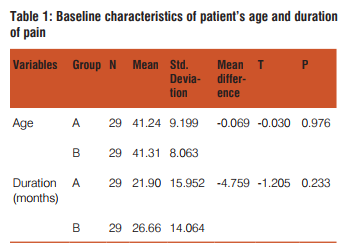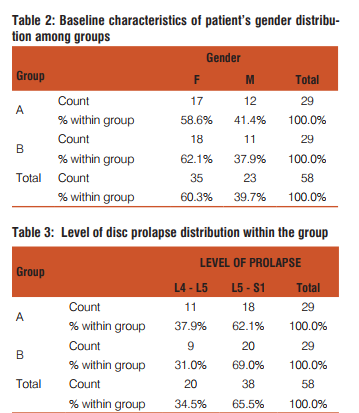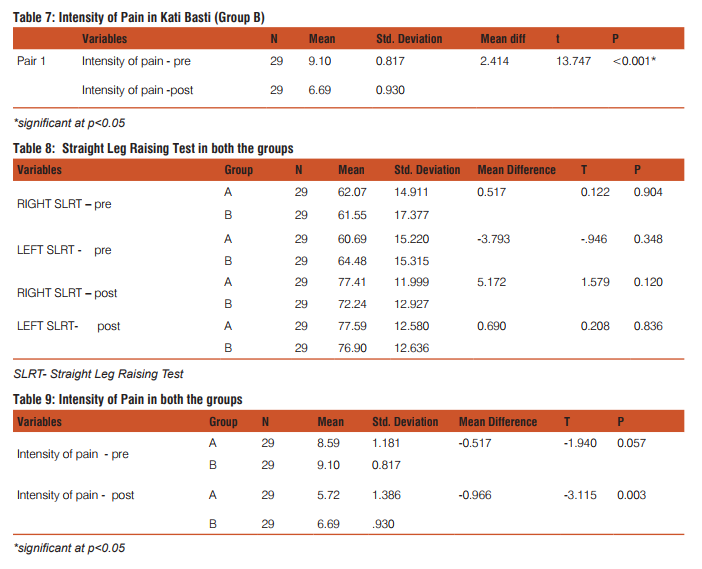IJCRR - 7(15), August, 2015
Pages: 44-48
Date of Publication: 11-Aug-2015
Print Article
Download XML Download PDF
COMPARISION OF TRANSCUTANEOUS ELECTRICAL NERVE STIMULATION AND KATI BASTI FOR PATIENTS WITH SCIATICA
Author: Sabnam Hashmi, Abdul Rahim Shaik, Padma Kumar Somasekharan Pillai
Category: Healthcare
Abstract:Study Design: Experimental study. Background: The majority of the people experience low back pain at some point in their life. World data reveals 40 % or more people have sciatica due to lumbar disc prolapse mostly in younger adults in association with 50-70% lifetime incidence of low back pain. Objective: To compare the effectiveness of Transcutaneous Electrical Nerve Stimulation and Kati Basti in reducing the Sciatica. Method: Fifty Eight patients with chronic pain were recruited for the study. Investigator explained the study to the patients and obtained an informed consent form and they were divided into two groups such as group A (Transcutaneous Electrical Nerve Stimulation) and group B (Kati Basti).Twenty nine patients were given Transcutaneous Electrical Nerve Stimulation and 29 patients were given Kati Basti for two weeks. Outcome measures were assessed before and after the treatment in both groups. To measure the angle of movement and intensity of pain Straight Leg Raise Test and Visual Analogue Scale were administered respectively before and after the treatment for both groups.
Results: The study shows that after two weeks of intervention, there was a significant reduction of pain and improvements in Straight Leg Raise Test in both the groups from baseline. Thus, both interventions were found to be effective in reducing pain for patients with sciatica. However, Transcutaneous Electrical Nerve Stimulation was more effective than Kati Basti in relieving the pain. Conclusion: Both the interventions, Transcutaneous Electrical Nerve Stimulation and Kati Basti, were effective in improving Straight Leg Raise Test and reducing the pain. However, patients in Transcutaneous Electrical Nerve Stimulation have improved more in terms of reduction of pain than in patients who were treated with Kati Basti after two weeks of treatment.
Keywords: Straight leg raising test, Transcutaneous electrical nerve stimulation, Kati basti intensity of pain, Sciatica
Full Text:
INTRODUCTION
World data reveals 40 % or more people have sciatica due to lumbar disc prolapse mostly in younger adults in association with 50-70% lifetime incidence of low back pain. Sciatica involves compression of the sciatic nerve roots caused by a herniated (torn) or protruding disc in the lower back that causes radiating pain in the distribution along the course of sciatic nerve in the hip, thigh lower leg and reaches up to the foot. The prevalence of sciatic symptoms reported in the literature varies considerably ranging from 1.6% in the general population to 43% in a selected working population1, 2. There are number of treatment options available for sciatica. However, Transcutaneous Electrical Nerve Stimulation (TENS) is a simple, non-invasive analgesic technique that is used extensively in health-care settings by physiotherapists for sciatica3 . The use of conventional (high-frequency) Transcutaneous Electrical Nerve Stimulation is originally based on the gate-control theory of pain, which suggested that counter stimulation of the nervous system could modify the perception of pain. Later studies suggested that with lowfrequency, high-amplitude (acupuncture-like) stimulation, TENS could also raise endorphin levels in the spinal fluid4,5. Kati Basti is one of the treatments of Keraliya Panchakarma for Gridrashi (sciatica) in ayurveda. The word Kati Basti is formed by combining two letters ‘Kati’ and ‘Basti and it is the procedure in which Dough-well is formed bywarm medicated oil which is placed on Kati (lumbo-sacral region) for a specified period of time (40 to 45 minutes) while the patient is lying prone position6,7. A study conducted by Khagram RV (2004) showed that the patients treated with Kati Basti had relief in the symptoms of pain and Straight Leg Raising Test8 . Transcutaneous Electrical Nerve Stimulation was significantly effective in decreasing the pain9 . In order to find the outcome measures, Visual Analogue Scale (VAS) scores and Straight Leg Raise Test (SLRT) were used. The Visual Analogue scale(VAS) is a simple and frequently used method for the assessment of variations in intensity of pain. The Straight Leg Raising Test (SLRT) is a useful measure because immediate effects of treatment can be determined. However, studies have been conducted using Kati Basti and other modalities in physiotherapy to find out the effectiveness in reduction of pain in sciatica, but studies on effectiveness of Kati Basti and TENS in sciatica have not been conducted in this region. Hence, the current study was undertaken to find the effectiveness between TENS and Kati Basti in reducing pain in sciatica patients caused by herniated or protruding disc.
MATERIALS AND METHODS
The present study is an experimental study conducted in 60 Sciatica patients of age group ranging from 18 to 50 years. The inclusion criteria were patients with Sciatica more than six weeks, and SLRT positive between 30º to 70º. Patients with the history of piriformis syndrome, spinal stenosis, spondylolisthesis, tuberculoma causing cord compression, diabetic neuropathy, and contraindicated for TENS and Kati basti were excluded. Participants were divided into two groups such as group A and B. The sciatica patients admitted in Yenepoya Medical College Hospital and Shaffi Ayurvedic Nursing Home constituted the population of the study.
PROCEDURE
The approval from the University ethical committee was obtained prior to the commencement of the study. Total of 75 patients with history of chronic lumbar radiculopathy were screened those who are admitted in Yenepoya Medical college Hospital and Shaffi Ayurvedic Nursing Home Mangalore. Out of 75 patients 15 patients were not met the inclusion criteria, hence a total of 60 patients were included as participants for the study. The patients were assigned into two groups by a convenience sampling method. Each group consisted of 30 patients. Group A - Patients admitted in Yenepoya Medical Hospital and given treatment Transcutaneous Electrical Nerve Stimulation for 2 weeks. Group B - Patients admitted in Shaffi Ayurvedic Nursing Home taking treatment Kati Basti for 2 weeks. However, one patient from Group A did not participate in this study due to severe pain and undergone surgery and one patient from Group B due to hypersensitivity of heat. Hence, a total 29 patients in each group have undergone a procedure. Patients were explained about the study in their local language and informed consent was taken from each patient. Patients in the Group A, received TENS with frequency of 2Hz pulse duration of 0.2 ms and intensity was given until getting visible muscle contractions for 20 minutes daily for two weeks by the same researcher. Electrodes were placed and secured with Velcro straps on the affected leg as well as back in the course of Sciatic nerve. Patients in Group B received Kati Basti treatment by the Ayurvedic physician, in the presence of researcher, in which warm medicated oil was applied to the lumbo-sacral region daily for 45 minutes for two weeks. After administration of two weeks of treatment, outcome measures of Group A, was assessed by another Physiotherapist in the presence of researcher, whereas Ayurvedic physician in the presence of the researcher assessed Group B.
OUTCOME MEASURES
Straight Leg Raising Test was administered prior to the treatment by using goniometer to find the angle of movement. To measure the angle of SLRT, patients were asked to lie down on his or her back on an examination table. The examiner lifts the patient’s leg passively while the knee is straight until patient experiences pain in course of sciatic nerve and the angle was measured by goniometer. Intensity of Pain was measured by Visual Analogue Scale.
DATA ANALYSIS
The Data was analyzed by using SPSS version 17 software. Demographics were done by using Unpaired t test(age and duration), Fishers exact test(Gender) and between the two groups Paired t test was used. P value less than or equal to 0.05 was considered to be significant.
RESULTS
Baseline characteristics of the 58 patients in two treatment groups are presented in following Tables. The two groups were considered comparable for all measured baseline characteristics.




DISCUSSION The Study was conducted to compare the effectiveness of Transcutaneous Electrical Nerve Stimulation (TENS) and Kati Basti in 58 Sciatica patients (29 in each group) by means of Visual Analogue Scale(VAS) and Straight Leg Raise Test(SLRT). Physiotherapy and Ayurveda modality are most commonly used as conservative treatments in India for Sciatica patients. Result of the study shows that the degree of SLRT was improved in both right and left lower extremity in TENS group (p< 0.001) and Kati Basti group (p< 0.001). A study by Melzack R et al revealed that SLRT for left and right leg after TENS treatment was improved (p<0.005) in patients with Sciatica10. The study found that TENS was effective in relieving pain in Sciatica patients. The results showed that pain reduced by 2.86 on VAS. Ghoname EA et al., found that the intensity of pain was reduced by 1.6 on VAS 10. Hence, the result of present study and various studies conducted elsewhere found that TENS is effective treatment in reducing Sciatica pain11- 13. The study also found that there was significant reduction in sciatica pain in Kati Basti treatment. A similar result was found in another study that there was improvement in reduction of pain in 50% of cases and Straight Leg Raising Test 60% of cases in Kati Basti14. Result of the study also showed that intensity of pain reduced from 8.59 to 5.72 in Group A and 9.10 to 6.69 in Group B on Visual Analogue Scale. Comparison between the groups showed that both groups were effective in reducing the pain in Sciatica however Group A shows more improvement than Group B (p=.003). Similar study15 found that there was significant improvement for the conventional Transcutaneous Electrical Nerve Stimulation in both the objective outcomes (VAS and SLRT) and functional measurements. A study evaluated the therapeutic effect of Kati Basti in patients of Sciatica and revealed that there was a statistically significant improvement seen in the parameters like magnitude of pain, neurological deficit, functional ability and functional disability16. The primary finding of this study was that the use of TENS and Kati Basti is improving the condition and symptoms. Patients suffering from low back pain with Sciatica in India have the option to choose between Allopathic medicine and traditional medicine. There are no studies to be found in the major databases comparing the treatment of low back pain with Sciatica in physiotherapy and Ayurveda. Hence, our aim was to explore how physiotherapists and Ayurvedic physicians in India work with patients suffering from low back pain with Sciatica. Both treatments were found to be effective in relieving pain and improving the range in SLRT in patients with low back pain with Sciatica.
CONCLUSION
The work was performed to ascertain out the result of treatment offered by physiotherapists and Ayurvedic physicians in India for patients suffering from low back pain with Sciatica. The information presented here concludes that Transcutaneous Electrical Nerve Stimulation and Kati Basti were found to be effective in alleviating the pain and improving the range in Straight Leg Raising Test in patients with Sciatica. However, the analgesic action of Transcutaneous Electrical Nerve Stimulation by acting on both peripheral and central nervous system was more effective in relieving pain than the Kati Basti.
ACKNOWLEDGEMENT
Authors acknowledge the immense help received from the scholars whose articles are cited and included in references of this manuscript. The authors are also grateful to authors / editors / publishers of all those articles, journals and books from where the literature for this article has been reviewed and discussed.
References:
1. Conditions of the Spine. Lumbar Radiculopathy. [Updated 2010; Cited 2012 Dec 3]. Available from http://www.njpcc.com/conditions-of-the-spine/lumbar-radiculopathy-sciatica.html.
2. Konstantinou K, Dunn KM. Sciatica: review of epidemiological studies and prevalence estimates. Spine. 2008; 33: 2464–2472.
3. Pope G, Mockett S, Wright, J. A survey of electotherapeutic modalities: ownership and use in the NHS in England physiotherapy. 1995; 8:82-91.
4. Sjolound BH, Eriksson MBE. Endorphin and analgesia produce by peripheral conditioning stimulation. Adv Pain Res Ther. 1979; 3:587-90.
5. Melzack R, Wall PD. Pain mechanisms: a new theory. Science. 1965; 150:971–9. 6. Shridhr BS. Managemnt of Gridhrasi w.s.r. to Basti- G.C.I.M. Mysore; 1991.
7. Bharati, Kumar A, Bhikshapati T. Kati Basti - A Clinical Study. AYU. 2008; 29(1): 42-45.
8. Khagram RV. A comparative study of Kati basti and Matra bati in management of sciatica. Gau jam. 2004.
9. Ghoname EA, White PF, Ahmed HE, Hamza MA, Craig WF, Noe CE. Percutaneous electrical nerve stimulation: an alternative to TENS in the management of sciatica. Pain. 1999; 83(2):193-9.
10. Melzack R, Vetere P, Finch L. Transcutaneous electrical nerve stimulation for low back pain: A comparison of TENS and massage for pain and range of motion. Phys Ther. 1983;63(4):489- 93.
11. Hughes GS Jr, Lichstein PR, Whitlock D, Harker C. Response of plasma beta-endorphins to transcutaneous electrical nerve stimulation in healthy subjects. Phys Ther.1984;64(7):1062-6.
12. Han JS, Chen XH, Sun SL, Xu XJ, Yuan Y, Yan SC et al.Effect of low- and high-frequency TENS on Met-enkephalin-Arg-Phe and dynorphin A immunoreactivity in human lumbar CSF. Pain. 1991 Dec;47(3):295-8.
13. Salar G, Job I, Mingrino S, Bosio A, Trabucchi M. Effect of transcutaneous electrotherapy on CSF beta-endorphin content in patients without pain problems. Pain. 1981;10(2):169-72.
14. Sudesh G, Muralidhara S, Bhawana G. Effect of Matra Basti and Katibasti in the Management of Lumbar Disc Disease. IJPBA. 2012; 3(5):1271-1277.
15. Peter F. J, Harvey E J, Arcaro N, Kaczorowski J. Transcutaneous Electrical Nerve Stimulation for Short-Term Treatment of Low Back Pain–Randomized Double Blind Crossover Study of Sham versus Conventional TENS, Journal of Musculoskeletal Pain.2005;13( 2) :11-17.
16. Padmakiran C, Ramachandra R, Prasad U. N, Rao N. Role of Kati Basti in gridhrasi (lumbago sciatica syndrome) .IAMJ.2013;1(4):1-5.
|






 This work is licensed under a Creative Commons Attribution-NonCommercial 4.0 International License
This work is licensed under a Creative Commons Attribution-NonCommercial 4.0 International License